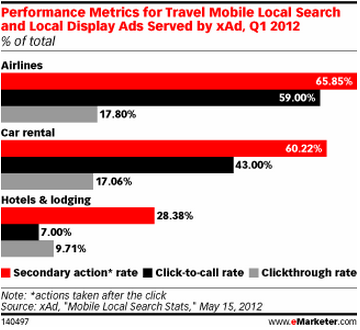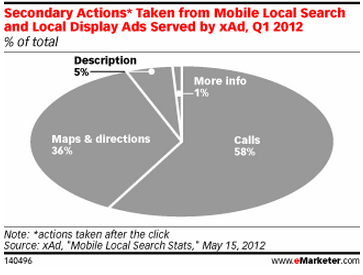Location Based Information & The Mobile Traveler
With mobile travel research and bookings still emerging and expected to grow rapidly, brands have an opportunity to get ahead of the curve. According to eMarketer estimations, 16 million people in the US will book travel on a mobile device this year, with that figure set to more than double to 36.7 million people by 2016.
Part of mobile’s appeal to travel consumers is its ability to draw on location-based information, aiding customers on the move who are looking for car rentals, hotels and other services on short notice.
A Q1 2012 report by mobile-local ad network xAd found that almost half of all local travel searches completed on a mobile device in the US were related to transportation. Travel agencies accounted for another 25% of searches, tours and attractions constituted 14% of searches and 12% of searches related to lodging and resorts.
Relatively high clickthrough rates were found for all three subcategories of hotels and lodging, car rentals and airlines. The CTR for ads shown after an airline search was an impressive 17.8%, followed by 17% for car rental searches and nearly 10% for hotel and lodging searches.
According to the report, the leading secondary action—the user’s next action after an initial click—for both car rental and airline searches was the placement of a phone call to a business, at 73% and 89%, respectively. For hotel searches, more than three-quarters of secondary actions consisted of looking at maps and getting directions.
These secondary actions are the result of reluctance among consumers to navigate brand websites on a mobile device. Instead of dealing with an inconvenient interface on a small screen, customers preferred to call businesses directly. In the case of those performing hotel or lodging searches, consumers turned to map and directions apps to find the information they sought. In both instances, users sought the most efficient path, underscoring why brands seeking to secure bookings from mobile customers must focus on optimizing local search with a click-to-call button in results.
In a new Location-Based Advertising and Marketing research report, Berg Insight estimates that the total global value of the real-time mobile LBA (Location-Based Advertising) market was €192 million in 2011, representing 5.0 percent of the total mobile ad spend. Growing at a compound annual growth rate of 90.9 percent, the real-time LBA market is forecasted to be worth € 4.9 billion in 2016, corresponding to 28.3 percent of all mobile advertising and marketing. Key drivers for LBA include the growing attach rates of location technologies in handsets, as well as the increasing consumer acceptance of LB Services in general.
Location is only one of many components in successful targeting, and marketers must also strive to leverage other contextual and behavioural information. High-precision real-time geotargeting is today sparsely used, and rightly so as most campaigns do not require targeting with an accuracy of a few meters. Hyper-local campaigns are nevertheless becoming more common.



COMMENTS